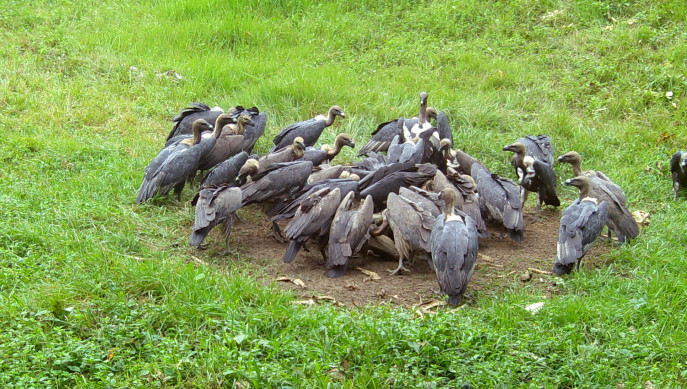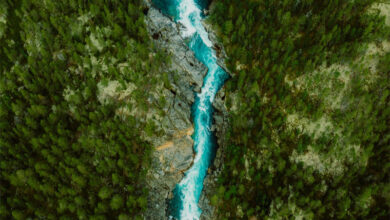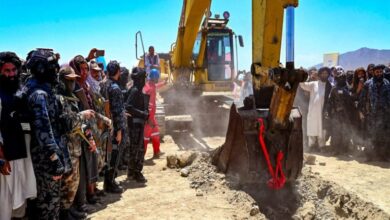Exclusive Interview with Dr. John Mallord: Saving South Asia’s Vultures from Extinction
Asia's vultures, especially the white-rumped ones, were once considered to be one of the world's most common large birds of prey. There were millions of them across South and Southeast Asia.

By Masum Billah
In an exclusive conversation with The Business Standard, Dr John Mallord, senior conservation scientist at the Royal Society for the Protection of Birds, discusses how vultures ended up on the verge of extinction in South Asia, in the crossfire of veterinary medicine and poison baiting due to human-wildlife conflict.
Dr John Mallord found his love for wildlife and conservation during his childhood.
“It was a fieldfare,” Mallord remembered writing a story on a migratory UK thrush when he was 10 years old. “In harsh snowing winters, sometimes you get them in your garden. My mother often offered apples to the birds. This one fieldfare defended the whole pile from all other birds.”
Another major influence was Sir David Attenborough.
“In the late 1970s, his original TV series Life on Earth came out. I watched that avidly and I remember being asked by teachers what I want to be when I grow up. I said I want to be David Attenborough,” Mallord said.
And Dr Mallord successfully followed his pursuit. He is now a senior conservation scientist at the Royal Society for the Protection of Birds (RSPB) UK and a board member of Saving Asia’s Vultures from Extinction (SAVE), which is a consortium of government and non-government organisations from the vulture-range countries of Asia.
Last year, Dr Mallord was present in Bangladesh when a white-rumped vulture was tagged for the first time. That vulture died this year because of poison baiting — the first officially recorded vulture death from poisoning in the country.
Dr Mallord is now in Bangladesh. He will be assisting the International Union for Conservation of Nature (IUCN) and the Bangladesh Forest Department to satellite tag more vultures to better understand the situation in Sylhet and Sundarbans region.
Satellite tagging of vultures helps understand their habitat, ecosystem, finding new nesting and roosting grounds, as well as identifying emerging threats.
In an hour-long exclusive conversation with The Business Standard at the IUCN Bangladesh office, Mallord discussed the history of the vulture tragedy in South Asia, how they ended up on the verge of extinction in the crossfire of veterinary medicine and poison baiting due to human-wildlife conflict, conservation efforts, and the future of vulture population in the region.

Tell us about the state of vultures in this region.
Asia’s vultures, especially the white-rumped ones, were once considered to be one of the world’s most common large birds of prey. There were millions of them across South and Southeast Asia.
You must have seen photos, for instance, from carcass dumps in Delhi where thousands of birds are waiting. They were incredibly common. I remember my first trip to India in 1992, walking down the wide boulevards of New Delhi and there were vultures perching on the buildings as well.
Dr Vibhu Prakash of the Bombay Natural History Society was studying vultures at Keoladeo National Park in Rajasthan. He was the first to notice that something was seriously decimating the vulture population. He used to monitor vulture colonies and observed a precipitous decline in the number of nests.
There was another survey on all raptorial birds. There was data. There was something to compare between past and present. These repeated surveys of the same transects revealed a drastic downward trend. This was in 2002.
By 2007, there was another survey on all vulture species in India. It revealed a 95% or more decline. One species, the white-rumped vulture, had declined by 99.9%.
Can you just imagine what that means? For every thousand vultures in 1992, there was just one left.
What happened to them?
No one correctly knew for many years. Researchers from the Peregrine Fund, led by Dr Lindsey Oaks with the Ornithological Society of Pakistan, discovered that the veterinary drug diclofenac was the cause. The study showed diclofenac, which became widely available in the mid-90s for veterinary purposes, coincided with the decline of vultures. So that was a suspect.
The researchers started collecting carcasses of dead vultures, which were quite common because millions were dying every year. At the height of the crisis, there was a 50% mortality rate in vultures. They did post-mortems and analysed blood samples.
Post-mortem showed signs of visceral gout — a build-up of uric acid crystals on the organs such as the liver and kidneys. The blood samples revealed that the birds that had visceral gout also had residues of diclofenac in their blood. It was a perfect pattern.
The researchers also experimentally tested the drug on vultures at different doses. They gave increasing doses of diclofenac and noticed that above a certain level, all birds died. Some birds died even at very low doses. So that kind of showed proof beyond any doubt that diclofenac was the cause of the vulture population decline.
With RSPB a part of the team working on that, I found the same result in dead birds. If they had visceral gouts, they had residues of diclofenac.
Now diclofenac was a bit of a wonder drug and livestock owners loved it.
It would work very quickly and effectively on cattle. But the problem is if the cow dies soon after being given a dose, there is still diclofenac in the carcass. That was the problem. When the vulture came across it, they would consume diclofenac residue. [Diclofenac was eventually banned in India, Nepal, Pakistan and Bangladesh].
What is the global picture of vulture decline?
The scavenging birds seem to be one of the most badly hit species globally. If you look around the world, there are very few places where they are doing well. African vultures are also in crisis, but in different ways.

As a result of human wildlife-conflict, farmers will contaminate an animal to kill a predator or dog that is attacking their livestock. But what they don’t realise is the collateral damage which can kill hundreds of vultures through a single poisoned bait.
And then there are other forms in Southern Africa which they call sentinel poisoning of vultures, for the kind of alerting role vultures play, and it is done deliberately by poachers.
As vultures can track carcasses from miles away, that is a problem for illegal hunters. Vultures’ aggregation can be a potential clue of any illegal hunting. So much so, poachers, fearing that the patrolling forest rangers might track them down by following vultures, deliberately kill vultures by poisoning them.
Say, after killing an elephant, they would poison the carcass after taking the ivory. Loads of vultures soon follow suit and feed on the poisoned flesh, which will kill them in the hundreds.
How many vultures are left in Bangladesh and the wider region?
We don’t have any historical figures from Bangladesh unfortunately. So we don’t know how many there were say back in the early 1990s — a kind of baseline with which to compare the situation now. We know from different surveys which IUCN carried out that over the last 10 years that they have remained stable but low in numbers. We are looking at only around 250 birds in Bangladesh.
In India, it is estimated that there might be between 10,000 to 20,000 white-rumped vultures, and perhaps 40,000 Indian vultures. There might only be about 1,000 slender-billed vultures, globally — they are the rarest species.
Nepal has been one of the great success stories and, since 2013, the populations [of vulture] have increased and recovered quite well.
What is Nepal doing right?
When diclofenac was identified back in 2003, one of the first things that conservationists in these countries did was advocating the government to ban the drug. A strong support for that ban came from the identification of another nonsteroidal anti-inflammatory drug (NSAID) meloxicam, which was safe for vultures.
People carried out safety testing, they would give the drug to vultures and see how they responded. Whereas they died with diclofenac, they survived the meloxicam. They gave it to an increasing number of birds, and they all survived. That work was published in 2006, which made it easier for the government in India, Pakistan and Nepal to ban diclofenac, because the scientists gave them an alternative. The drug was banned in the same year.
One of the great things that happened in Nepal was that the government instigated an exchange scheme for pharmacists. So, they said, “Give us all your diclofenac, but in return, here’s meloxicam. It is all free. And things quickly turned around ever since.”
Until about 2013, Nepal was hard hit as well. It wasn’t till these conservation actions really kicked in that the population started to increase again.
How is the adaptation of meloxicam going in Bangladesh?
In Bangladesh, diclofenac disappeared, and it never really returned. Unfortunately, another NSAID ketoprofen became the drug of choice, which is also toxic. It is now banned. They did well.
The government banned it first in two vulture safe zones, and then across the whole country. It has been recently banned in India as well. So, diclofenac disappeared, ketoprofen is declining and being replaced with safe drugs.
How is the loss of vultures impacting the environment?
One of the great things about vultures is that they do clean up the environment of carcasses. Cattle carcasses, left often to rot, can be a source of disease.
Vultures, for millions of years, played the role of cleaning up the environment of those carcasses. The loss of vultures seems to have led to an increase in feral dog population as well.
Because, with no vulture, the carcasses just stay there, and the dogs have no competition. They can feed on carcasses, grow healthy and have lots of puppies. This increased the number of dog bites in humans and possibly the spiked cases of rabies and associated costs in rabies treatment.
How do you evaluate current vulture protection measures?
SAVE is the consortium of organisations across the six vulture range countries, including India, Pakistan, Nepal, Bangladesh, Myanmar, and Cambodia. These countries came together with others like the RSPB. People in the US have been involved.
They came together to coordinate the conservation actions.
So, once diclofenac was identified, several goals were suggested. Number one was to get rid of diclofenac — get the ban in place. If they had stayed in circulation for much longer, the vulture certainly would have gone extinct. That’s the first step.
The second step was establishing a breeding program. There is a desperate need for a safety net population. In case of any worst-case scenario of the extinction of wild birds, the captive breeding population can be used as a stock to re-establish these populations in the world.
The diclofenac is now banned, and breeding programs are established in India, Pakistan and Nepal. Captive-breeding is successful for all Gyps vultures in India: white-rumped, long-billed, and slender-billed vultures. While the breeding initiative continues in Pakistan, Nepal was so successful in protection and increasing numbers that captive breeding programs are now closed.
And the third initiative, I suppose, is to initiate the vulture safe zones. The idea is securing an environment safe to birds.
How do radio colouring and tagging the white-rumped vultures benefit conservation efforts?
The satellite tracking is kind of a direct measure to see if toxic medicines like diclofenac are in the environment. Because one of the greatest things about satellite tracking is they give you an unbiased measurement of vulture survival.
We have tagged about 70 white-rumped vultures in Nepal since 2017, followed them closely over that time and discovered that they have an annual survival rate of 97%.
You can stay alert to any unusual deaths. You can recover the carcass, carry out a post-mortem, take samples, analyse and find out the cause of death. These are the great benefits of satellite-tagging.
In Bangladesh, it is a new program. We tagged one white-rumped vulture last year. And it was interesting to know how the bird travelled to India. It was instigating some transboundary work with collaborators on the Indian side of the border.
By following the movement of this bird and discovering when the bird stopped travelling, we travelled to the site, found the dead vulture and discovered that it had been poisoned. You know, without the tagging, we would never have probably learned what happened to that bird. [Around 14 vultures died because of poisoning in Moulvibazar earlier this year.]
How can we save vultures from poisoning, such as that in Moulvibazar, for example?
It is too large a problem to be dealt with purely at an NGO level. The vulture safe zone teams have been working with locals and advocating against diclofenac, etc. Where poisoning is an issue, they also talk to the local people about it. So that goes on.
But the thing is, they might ignore that because they are losing their livelihoods as predators are killing their livestock. When I say it’s too large an issue, I feel that the poisoning issue needs to be addressed with importance. However, that could take new legislation at government level. If they get compensation for their loss of cattle, poisoning might stop. But that sounds like too big of an initiative.
To be honest, I think that is what is needed. The advocacy and kind of education could work to some extent, but in my opinion, I think it needs more. It needs that kind of legislative programme where money is set aside as compensation for local farmers for loss of livestock. Until that step is taken, we might struggle with poisoning issues.
What does the future of vulture conservation look like?
There has been huge success; the bottom line is they didn’t go extinct — it may sound like a silly thing to say, but at one point it looked like they would. So the fact that they haven’t gone extinct in any of these countries is a huge success.
However, there is still work to do. One thing to realise is that they are still at a very low level, obviously in comparison to the early ’90s before the crash. Now, say a new NSAID suddenly appears and is offered to pharmacists that finally reaches cattle and that turns out to be toxic. What if it was as toxic as the diclofenac? What if we start losing 50% of vultures again? It wouldn’t take long for the complete extinction.
Besides, we have had avian flu epidemics around the world decimating bird populations. With vulture’s number in such a low, it wouldn’t take much to knock them out again.
The work must continue. It is important that the monitoring works go on.




